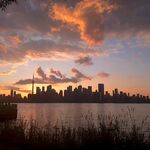The Star
Link to article
Living beside the Gardiner
Nov. 26, 2006. 07:21 AM
ANDREW CHUNG
The Gardiner Expressway may be just beyond her bedroom balcony, close enough that you can imagine taking a running leap onto it, and yet Marie Blanchard never has trouble sleeping alongside the sound of endless traffic.
Except for one night last August, when Blanchard was awakened not from the elevated freeway's incessant noise, but by its peculiar absence.
A few kilometres west, near Jameson Ave., a terrible event had unfolded: two street racers lost control and crashed into a car driven by a 58-year-old nurse, catapulting her Volvo off the guardrail and into a ditch below. The nurse survived, but the crash stopped traffic dead.
"All of a sudden it was totally quiet, instead of its usual hum," says Blanchard, 62, a retired teacher.
"That's what woke me up."
Blanchard is part of a growing legion of Toronto residents who find themselves in a unique situation: living alongside not another house or apartment, not a parking lot or a quiet street, but rather a high-speed expressway.
The Gardiner is one of Toronto's main arteries. It connects Highway 427 and the Queen Elizabeth Way in the west and the Don Valley Parkway in the east. It rises above the ground at Dufferin St., continuing into the downtown core.
It was completed in the 1960s, and since then there have been no new major roadways that lead to downtown despite a hugely expanding population. The Gardiner has thus become so busy that up to 200,000 cars take it each day, according to the city. It carries peak-period traffic for 12 hours each day from 7:30 a.m. to 7:30 p.m. Gridlock and parking lot-style conditions are now commonplace.
Meanwhile, towering condominiums have sprouted up, mostly in the past five years, to accommodate a residential renaissance downtown. Many of them are being built on lots that straddle the expressway. That means some units in these buildings are inevitably being built just metres from the guardrails.
The city requires that the buildings be set back at least three metres from the Gardiner. "We have had discussions with developers who don't want to give us even that," says John Bryson, manager of structures and expressways for the city's technical services division.
The tight three-metre rule is the minimum gap needed to ensure proper maintenance and inspection of the roadway. When it comes to safety, the guardrails are all "crash tested," Bryson says.
The chances of a car jumping the guardrail and crashing into a building, he says, are extremely slim. There's a risk anywhere you live, he adds. "Anybody who buys a house near the airport takes a risk of a plane crash." In some north-facing units in the condos at York and Yonge Sts., on the south side of the highway, it feels as if you could reach out and touch the pavement.
More buildings could also be constructed flush with the Gardiner west of Yonge St. The city recently approved a zoning bylaw for "East Bayfront," between Jarvis and Cherry Sts., that allows for shorter buildings along the water, but taller ones close to the Gardiner.
Walk into Blanchard's two-bedroom condominium along Queens Quay W., just west of York St., and the boxy gray Gardiner nearly smacks you in the face. From the large windows in her kitchen and den, not to mention the balcony doors in her bedroom, the Bay St. off-ramp and the express portion of the roadway dominate the landscape, like a drab industrial painting.
"It's an interesting view," she says, smiling. "I wouldn't say it's fabulous. But it's interesting. I can watch the traffic jams when they happen." Overall, the Gardiner "doesn't bother me," she shrugs. "I kind of like it."
Despite her proximity to tens of thousands of car and truck tailpipes spewing hydrocarbons at her doorstep, the pollution doesn't worry her. "When you move downtown, it comes with the territory," she says.
But the fact is that epidemiologists are becoming worried about tiny "particulate matter" that growing research is implicating in respiratory and cardiac illness, even death. These particles, produced from vehicular exhaust and moving parts wearing down, can be anything from metals to organic compounds to black carbon. Some of these particles, called ultrafine, are virtually weightless, so small that at least 10,000 could fit end to end across the width of the average little finger, making them easily absorbed by the lungs, but not easily removed by immune cells.
Recent studies provide mounting evidence of a spike in levels of these particles near freeways, as opposed to other urban areas. One 2004 study carried out astride Canada's busiest expressway, the 401 in Toronto, measured particulate matter at the roadway and distances from it. It showed that from the roadway to 300 metres away, larger particles dropped by about 60 per cent, and ultrafine particles dropped by an astonishing 80 per cent, to levels approaching residential areas.
"There's ample data from around the world that proximity to highways is a risk factor for respiratory and cardiac problems," says Jeff Brook, senior research scientist and urban air quality specialist at Environment Canada, who helped conduct the study.
While the investigations to date have been at roadside, it's not clear what effect there would be on those who live on higher floors of these buildings, he adds.
With the doors and windows closed in Blanchard's condo, you can hear only a slight hum from the cars and trucks, the soundproofing evidently quite good. Open the balcony doors, however, and the din of the traffic rushes in. It's not as bad as a blasting stereo from an upstairs neighbour, but it's loud and incessant.
It doesn't bother Blanchard. "It's almost like white noise."
This might have something to do with personality history. Blanchard grew up in Toronto's east end, near streetcar barns, a police station and a fire hall. The sounds of a city were second nature to her. In adulthood, when she moved to Markham to raise her family, it was next to a working farm. There, it was nature, in the form of a rooster that kept her awake. She moved back downtown four years ago.
"I was born in the city, I grew up in the city, I was longing to come back to the city," she says.
Others who count the Gardiner as their front yards also say it's not as bad as you might think. Shastri Singh, 25, walks out of his small, eighth-floor condo and on to his sprawling balcony. The sun has set, and so the Gardiner is an arresting ribbon of white and red lights. This is his favourite time.
"It's mesmerizing," he says, leaning into the wind. "They look like little toy cars flying by."
His condo is situated along curving Fort York Blvd., which connects Bathurst St. with Lake Shore Blvd., so his view of the Gardiner is expansive, as if parallel to a runway.
Singh, an information technology worker on Bay St., says you have to have the right personality to live there. "I like being entertained all the time," he explains. "If you're fast-paced, you like to see life going by rather than just sitting like a stone all bored. It's okay."
The action never ceases, and sometimes full-blown tragedy occurs. In August, a motorcyclist who popped a wheelie crashed into the guardrail and died. Singh witnessed the aftermath from his balcony.
If you're driving on the expressway, his building is one of the first entering downtown that you might get to know intimately. Singh doesn't hesitate to wave back at motorists who wave at him as they pass by.
"On Friday and Saturday nights, a lot of people come in to go partying. Sometimes they're in limos and you can hear them yelling, getting rowdy. You see a lot of hot chicks sticking their heads out. They've waved at me; they're all drunk."
Such a scenario confounds scholars of urban planning. "You don't know if the freeway works as a TV for them, or are we drivers on the freeway intruding into their privacy," wonders Ute Lehrer, co-ordinator of the planning program at York University. "Are you the viewer or are you viewed?"
The pace of the condo boom in downtown Toronto is transforming the city into something akin to the fabled Metropolis in the film by Fritz Lang, with its space-age buildings and zigzagging flyovers, says Lehrer, who is currently studying Toronto's condo resurgence. "With these condo towers going up left and right next to the Gardiner, we literally live in this movie."
Toronto is not alone in having people in transit next door to living rooms. Take the elevated subways in Chicago, New York or Berlin. Neither is it unique to have a highway cutting a path through residences. That exists in Tokyo and Hong Kong. But Lehrer says in these cases, the towers and roads were built hand in hand. Here, the towers are coming long after the road was laid down.
That the condos keep going up is a worry for the Toronto Waterfront Revitalization Corp. The agency says constant development leaves less room (and makes it more expensive) to take the Gardiner down, which it proposes doing between Spadina Ave. and the Don Valley Parkway as a key to transforming the waterfront and removing the main "barrier" to it.
However, with the many condos lining up along its span like dominoes, some say that even if the Gardiner vanished, there would still be a "barrier."
"We should not make the Gardiner responsible for not having access to the waterfront," says Lehrer. "The reason we don't have access is because of the condo towers that are going up right now."
People who live life beside the fast lane might prefer that the Gardiner come down, but for different reasons. A few floors below Singh, speech language pathologist Dena Smith is pretending to give the traffic report. "Right now I see the top of an SUV, the top of an 18-wheeler, another SUV — traffic is really moving well eastbound."
There's sarcasm in her voice. She's not so enthusiastic about her concrete neighbour. When she bought her unit, she says she didn't realize just how close it would be. "It's very strange," Smith, 36, says of living there.
"I'm looking forward to the Gardiner being demolished one day," she says. "I'm concerned about pollution. There are days when it's noisy. And when traffic is bad, I don't have my blinds open because in an SUV or truck, someone can look straight into my window."
But Smith calls herself a "downtown girl," and until she has a family, this condo will do. Plus, it was affordable. "Either you buy where you can't afford it in the city, or you compromise and say, well, the Gardiner is there, or the train tracks are there."
She's getting used to it. Just like the others. And there's a unique bonus. When friends are coming over, she can pop her head out the window and tell them with confidence whether they're going to be late.




